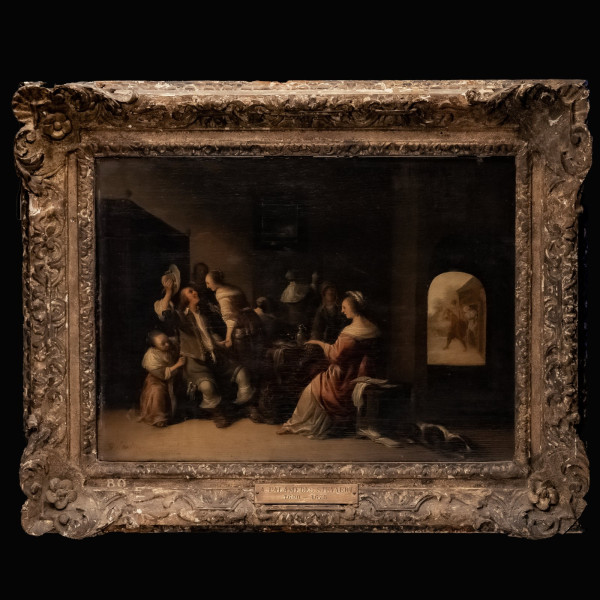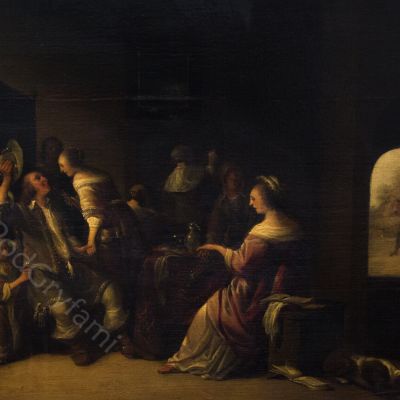Anthonie Palamedesh (Stevers)
Price range: 





 (> 50 000 zł)
(> 50 000 zł)
This is a wonderful example of 17th century genre painting from this artist. The work presents the interior of the guardhouse used for resting by the guard services. In the foreground, a man, probably resting on a chair after service, is shown surrounded by four young, laughing ladies. The remaining three women seem to be serving this cheerful company. Two of them, turned backwards, lock the big wooden door and another one helps to tune the instrument. Their clothing (tightly covered shoulders, modest dresses, caps covering hair) indicates that they are maidservants. The work brings with it a certain erotic subtext. A gentle caress of the hand of a woman leaning over a man, a kneeling lady helping him to take off his clothes, a slanted straitjacket, partially stretched plumes, riding boots lowered to half a calf, or a large bed with a canopy placed on the left side of the painting. Through these details, the author perfectly captured the intimacy of the characters. On the right side of the painting, as if in an open, luminous half arc of a window, we can see two more people coming out of the room. The work breathes out the elegance characteristic of Palamedesz, the figures come to life under his brush and simple gestures become somewhat sophisticated. A masterful light introducing a truly Rembrandt mood. The painting is in good condition and has been well preserved. There is a board with a visible, repaired crack at a height of 9.50 cm from the top edge leading the whole width of the painting. The signature is placed in the lower left corner, well embedded in the painting layer: "A Palamedesz." A brass plaque with the inscription A. Palamedes Stevaert 1600-1673 is mounted on the frame. The frame is in need of renovation.
About the artist: Anthonie Palmadesh (1601-1673) Born in Delft, he was a painter of the Golden Age of the Netherlands. Palamedes or according to some sources (E. BENEZIT, DICTIONNAIRE TOME 8) Palamedes - came from an artistically talented family. The artist's father was a cutter of semi-precious stones, which he later used to decorate various objects, both artistic and objects of everyday use. Shortly after Anthony was born, the whole family moved to England, where his father was called upon to serve the King of Scotland and England Jacob Stuart I (1566-1625). It was there that the younger brother of the artist Palamedes Palamedesz (1607-1638), who also became a painter, was born. After returning to his hometown, Delft, Anthony began to study painting in studios: Michiel Jansz van Mierevelt (1566-1641), one of the best portraitists of his time, and Hans Jordaens the Elder (1555-1630), a highly valued landscape painter. In 1621, the artist joined the oldest painting guild, St. Luke, which he chaired between 1656 and 1673. Palamedes was married twice and had four children, although here the artist's biographers are not entirely unanimous, as in the case of his nephew, another painter who was considered to be one of the greatest Dutch Baroque artists (Palamedes' son Palamedes I) Palamedes II (1631 - 1705). Some claim that he was the painter's son, not his nephew. Both brothers had sons named Palamedes born in 1631 (son of Palamedes I) and 1632 (son of Anthony), so the question of the artist's family connections is not entirely clear even to the researchers of the RKD (Dutch Institute of Art History). Palamedes lived and worked in an era of great masters such as: Peter Paul Rubens (1577-1640), Rembrandt Harmenszoon van Rijn (1606-1669), Frans Hals (1582/83-1666) or Jan Vermeer van Delft (1640-1675). Despite the stiff competition, the artist's works were not inferior to those of these great artists, which is why they adorned many eminent aristocratic houses in the Netherlands of that time. Palamedes created mainly genre scenes depicting the life of guards and entertainment, as well as the pleasures of aristocrats and the wealthy bourgeoisie, but he did not avoid portraits and drawings. A certain curiosity are the works of the artist with a slight erotic coloration or a multiple, moralistic message. Anthony died in 1673 in Amsterdam, leaving behind a great artistic legacy. His works can be found in the museums of the Netherlands, Great Britain or the United States at the Fogg Museum (Harvard University museum complex in Cambridge, Massachusetts). His works are also included in the collections of the Louvre in Paris, the St. Petersburg Hermitage, the National Museum in Warsaw, and for several years (since 2008) the National Museum in Wrocław, which has a painting from the period 1635/36 entitled "Exquisite Society in the Interior".
Details
| Title: | "Inside the Guardhouse" |
| Medium: | Oil on wood |
| Width: | 49 cm |
| Height: | 36 cm |







